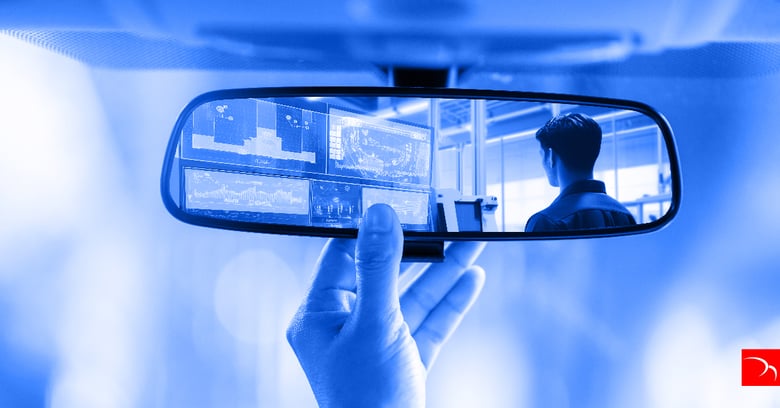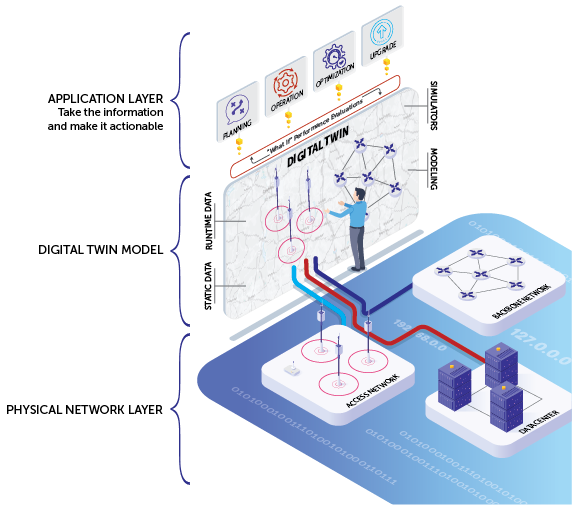Gain Full Visibility into Your Telecom Network with a Digital Twin.
Picture this: you’re in charge of running a network, and business is great. You’re adding network subscribers daily, and things are on the up and up. You’re adding services and advanced applications to your offering, and your customers are happy. You’re cruisin’.
And then, CRASH. Service to an entire sector goes out without warning…time to head to the pit. You scramble from office to office talking to your operations team, engineers, and NOC staff. As they each pull up one distinct system, spreadsheet, or NMS export after another, it dawns on you. This scrambling is a manifestation of the network information chaos you’ve been dealing with for some time.
Your teams are working in siloes – in separate lanes – alongside one another, but not in unison. Simply because that’s how it’s always been, and how the network evolved over time. It is no wonder they cannot pinpoint a solution to what you suspect could be a multilayered problem. Your technical teams – engineering & design, operations, planning, and even the network operations center (NOC) – cannot predict a problem if they have little visibility into what their colleagues are doing across the hall. They don’t know what they don’t know, and therein lies the problem.
There’s got to be a better way.
Communications networks of today are becoming smarter, denser, and more connected, offering users the faster speeds and modern luxuries promised by 5G (and 6G on the horizon). And with these BIG promises of faster speeds, an explosion of devices, and advanced applications, new-age networks are becoming more complex and denser, and so is the management and monitoring of them. Operators will need to move BIG data around, and FAST. The networks of today and the near future need more capacity, and equally as important, a sophisticated tool to bring everything together and keep the network functioning properly.
Enter the DIGITAL TWIN.
THE TELECOM DIGITAL TWIN
Let’s get something straight right away. One thing a network digital twin IS NOT is simply a network management system (NMS). It is so much more than that on multiple levels…but here we are getting ahead of ourselves again.
Let’s take a look in the rearview mirror for a moment. Historically, the concept of the digital twin, although an emerging technological concept in the networking space, has been around for decades. A real-time representation of physical assets in a digital world, it has been used in many industries such as aerospace engineering, utilities & energy, automotive engineering, manufacturing, and more. In fact, the concept first appeared with NASA’s Apollo program in the 1970s, where replicas of space vehicles were built on Earth to mirror the damaged conditions of the equipment during the mission, ultimately helping to bring the Apollo 13 crew home safely.
And things have certainly evolved since the ‘70s. Some recent use cases enabled by digital twin technology include wind farm operations, water management, intelligent transportation, and even long-haul Covid-19 management. Although there is no one unified framework defining the general purpose of the digital twin as of today, I think we all can agree, it’s going to have a powerful impact on our collective future business operations. In fact, Forbes ranked digital twins as #9 on their list of the 25 technology trends that will define the next decade, and Gartner named the digital twin as a strategic technology trend for three consecutive years, 2017-2019.
So how does all this relate to you? Let’s take a closer look at how this emerging technology can help YOU as a network operator.
THE DIGITAL TWIN FOR NETWORK OPERATIONS
A digital twin network (DTN) is a virtual representation of your physical network. DTNs can be useful for analyzing, diagnosing, emulating, and controlling the physical network based on data, modeling, and interface to achieve real-time, interactive mapping between physical networks and virtual twin networks.
Well that was...a lot. Let’s break it down. Why do you need a digital twin for your network?
So what’s with the fiber-only guidelines?
- Get rid of those silos: As networks evolve, so does the amount of data that needs to be “handled” and consolidated. Massive amounts of network data collected from your physical network assets can be stored in your digital twin network, providing you with a unified data repository and a single source of truth for your teams currently using disparate operating systems.
- Real-time, interactive data mapping: This is one of the most important factors for distinguishing the digital twin from a more basic network simulation system. It’s constantly interacting with your physical network, storing real-time, accurate data to work with and therefore giving you the most precise visualization of where your network stands today, at this very second.
- Data modeling: Various data models can be built in your digital twin, offering the ability to effectively predict “what if” scenarios. For example, what if I add a few smoke sensors out here in my network to catch a wildfire before it gets out of control? How will the data load from those sensors affect my network? With a digital twin, you will have that answer, without guesswork, and can plan accordingly.
- A standardized interface/architecture: This is a key enabler which can effectively ensure the compatibility and scalability of your DTN system. The general DTN architecture consists of the physical network layer, the digital twin layer, and the application layer. These three layers continuously “talk” to one another, northward and southward, thus providing you with real-time data and enabling you to run “what-if” scenarios effectively.
In addition to the massive benefits you gain from a technological standpoint, imagine the business benefits you could enjoy:
- Streamlined operations with one single source of truth – no more silos, no more guesswork, no more running from one department to another
- Optimized and informed decision making – taking the guess work out of the equation
- Resilience of the network – reducing downtime with better, more informed planning
- Optimized total cost of ownership
- Custom training – networks are never one size fits all, as other training programs might have you believe. This is training for YOUR network operations
FROM BLIND SPOTS TO CLARITY – 5 STEPS FOR RESTORING NETWORK ORDER
Interested? We are already using our proprietary digital twin technology today to expose serious network risks for major operators around the world. If you would like to gain insight into your potential problem areas – those places that are not even on your radar today – here are the 5 steps we’ll take you through so that you too can harness the power of a digital twin and stay a step ahead of any potential network problems.

- Model and Consolidate: Create a single source of network information by creating transparent communications between technical departments through APIs.
- Collect Data: Real-time collection of multi-vendor, multi-technology data into one unified repository.
- Visualize: Provide teams with enhanced visualizations of the network: transport topology, fiber topology, multi-layer topology, dashboards, network diagrams, service layers, and more.
- Access: Provide your entire organization with one network view. Google maps is an excellent example of this concept. Just as drivers can notify the app of hazards on their route, which is then automatically pushed to anyone else using the app, your various teams will have real-time insight into any network problems on the horizon.
- Generate Knowledge: Knowledge is power. The possibilities are endless, but to mention just a few here – capacity planning, optimization, preventative maintenance, anomaly detection, survivability analysis, and informed decision making.
KEEP YOUR SIGHTS SET ON US
We’re making waves over here at Ceragon, and we want you to join us as we set our sights on the future of networking. We know what our digital twin technology can do for your business – can we show you?
Join us for multiple opportunities to get a closer look at this advanced technology.
- Access our on-demand webinar, “Bring Network Blind Spots into Focus with Trailblazing Digital Twin Technology” for more in-depth information on what we can do for you.
- Contact us for a personalized consultation and hear first-hand how our digital twin technology can bring immense benefits to your network and business!
HAVE QUESTIONS? WANT A DEMO?



